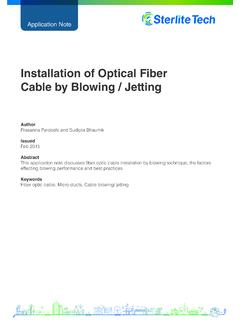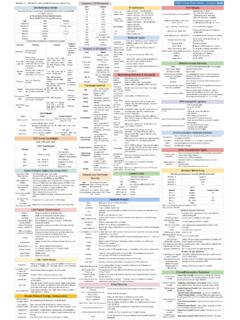Transcription of BEC701 - FIBRE OPTIC COMMUNICATION
1 BEC701 - FIBRE OPTIC COMMUNICATION . UNIT-I. INTRODUCTION TO OPTICAL FIBER. Evolution of fiber OPTIC system Element of an Optical Fiber Transmission link Ray Optics Optical Fiber Modes and Configurations Mode theory of Circular Wave guides Overview of Modes Key Modal concepts Linearly Polarized Modes Single Mode Fibers Graded Index fiber structure Introduction An optical Fiber is a thin, flexible, transparent Fiber that acts as a waveguide, or "light pipe", to transmit light between the two ends of the Fiber.
2 Optical fibers are widely used in Fiber- OPTIC communications, which permits transmission over longer distances and at higher bandwidths (data rates). than other forms of COMMUNICATION . Fibers are used instead of metal wires because signals travel along them with less loss and are also immune to electromagnetic interference. Evolution of fiber OPTIC system First generation The first generation of light wave systems uses GaAs semiconductor laser and operating region was near m. Other specifications of this generation are as under: i) Bit rate : 45 Mb/s ii) Repeater spacing : 10 km Second generation i) Bit rate: 100 Mb/s to Gb/s ii) Repeater spacing: 50 km iii) Operation wavelength: m iv).
3 Semiconductor: In GaAsP. Third generation i) Bit rate : 10 Gb/s ii) Repeater spacing: 100 km iii) Operating wavelength: m Evolution of fiber OPTIC system Fourth generation Fourth generation uses WDM technique. i) Bit rate: 10 Tb/s ii) Repeater spacing: > 10,000 km Iii) Operating wavelength: to m Fifth generation Fifth generation uses Roman amplification technique and optical solitiors. i) Bit rate: 40 - 160 Gb/s ii) Repeater spacing: 24000 km - 35000 km iii). Operating wavelength: to m Element of an Optical Fiber Transmission link Basic block diagram of optical fiber COMMUNICATION system consists of following important blocks.
4 1. Transmitter 2. Information channel 3. Receiver. Block diagram of OFC system The light beam pulses are then fed into a fiber OPTIC cable where they are transmitted over long distances. At the receiving end, a light sensitive device known as a photocell or light detector is used to detect the light pulses. This photocell or photo detector converts the light pulses into an electrical signal. The electrical pulses are amplified and reshaped back into digital form. Fiber OPTIC cable Fiber OPTIC cable consists of four parts.
5 Core Cladding Buffer Jacket Core. The core of a fiber cable is a cylinder of plastic that runs all along the fiber cable 's length, and offers protection by cladding. The diameter of the core depends on the application used. Due to internal reflection, the light travelling within the core reflects from the core, the cladding boundary. The core cross section needs to be a circular one for most of the applications. Cladding Cladding is an outer optical material that protects the core. The main function of the cladding is that it reflects the light back into the core.
6 When light enters through the core (dense material) into the cladding(less dense material), it changes its angle, and then reflects back to the core. Fiber OPTIC cable Buffer The main function of the buffer is to protect the fiber from damage and thousands of optical fibers arranged in hundreds of optical cables. These bundles are protected by the cable 's outer covering that is called jacket. JACKET. Fiber OPTIC cable 's jackets are available in different colors that can easily make us recognize the exact color of the cable we are dealing with.
7 The color yellow clearly signifies a single mode cable , and orange color indicates multimode. Both the light sources at the sending end and the light detectors on the receiving end must be capable of operating at the same data rate. The circuitry that drives the light source and the circuitry that amplifies and processes the detected light must both have suitable high-frequency response. The fiber itself must not distort the high-speed light pulses used in the data transmission. They are fed to a decoder, such as a Digital to.
8 Analog converter (D/A), where the original voice or video is recovered. In very long transmission systems, repeater units must be used along the way. Since the light is greatly attenuated when it travels over long distances, at some point it may be too weak to be received reliably. To overcome this problem, special relay stations are used to pick up light beam, convert it back into electrical pulses that are amplified and then retransmit the pulses on another beam. Several stages of repeaters may be needed over very long distances.
9 But despite the attenuation problem, the loss is less than the loss that occurs with the electric cables. Characteristics of fiber 1)Wider bandwidth: The optical carrier frequency is in the range 10^13 Hz to 10^15Hz. 2)Low transmission loss: The fibers having a transmission loss of 3)Dielectric waveguide: Optical fibers are made from silica which is an electrical insulator. Therefore they do not pickup any electromagnetic wave or any high current lightning. 4)Signal security: The transmitted signal through the fibers does not radiate.
10 Further the signal cannot be tapped from a Fiber in an easy manner. 5)Small size and weight: Fiber OPTIC cables are developed with small radii, and they are flexible, compact and lightweight. The fiber cables can be bent or twisted without damage. Operation of fiber A hair-thin Fiber consist of two concentric layers of high-purity silica glass the core and the cladding, which are enclosed by a protective sheath . Core and cladding have different refractive indices, with the core having a refractive index, n1, which is slightly higher than that of the cladding, n2.







